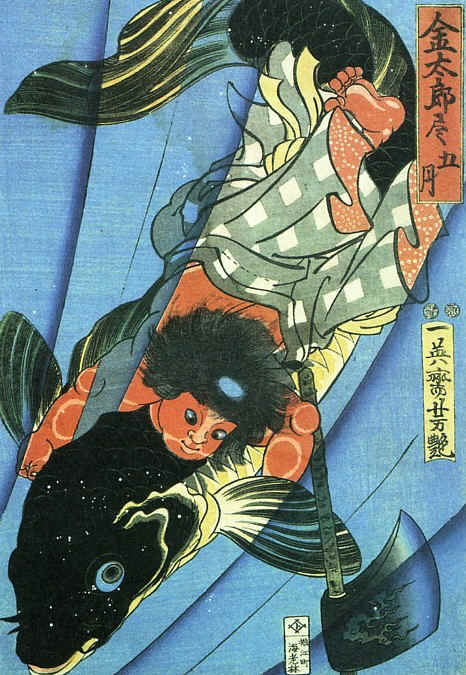Kintarō
(金太郎?,
often translated as “Golden Boy”) is a folk hero from Japanese folklore. A
child of superhuman strength, he was raised by a mountain hag on Mount Ashigara.
He became friendly with the animals of the mountain, and later, after catching
Shutendouji, the terror of the region around Mount Ooe, he became a loyal
follower of Minamoto no Yorimitsu under the new name Sakata Kintoki (坂田公時?).
He is a popular figure in noh and kabuki drama, and it is a custom to put up a
Kintarō doll on Boy’s Day in the hope that boys will become equally brave
and strong.
Kintarō
is supposedly based on a real man, named Sakata Kintoki, who lived during the
Heian period and probably came from what is now the city of Minami-ashigara. He
served as a retainer for the samurai Minamoto no Yorimitsu and became well known
for his abilities as a warrior. As with many larger-than-life individuals, his
legend has grown with time.
Several
competing stories tell of Kintarō’s childhood. In one, he was raised by
his mother, Princess Yaegiri, daughter of a wealthy man named Shiman-chōja,
in the village of Jizodo, near Mt. Kintoki. In a competing legend, his mother
gave birth to him in what is now Sakata. She was forced to flee, however, due to
fighting between her husband, a samurai named Sakata, and his uncle. She finally
settled in the forests of Mt. Kintoki to raise

A
young Kintarō battling a giant carp
her
son. Alternatively, Kintarō’s real mother left the child in the wilds or
died and left him an orphan, and he was raised by the mountain witch Yama-uba
(one tale says Kintarō’s mother raised him in the wilds, but due to her
haggard appearance, she came to be called Yama-uba). In the most fanciful
version of the tale, Yama-uba was Kintarō’s mother, impregnated by a clap
of thunder sent from a red dragon of Mt. Ashigara.
The
legends agree that even as a toddler, Kintarō was active and indefatigable,
plump and ruddy, wearing only a bib with the kanji for “gold” (金)
on it. His only other accoutrement was a hatchet (ono and masakari). He was
bossy to other children (or there simply were no other children in the forest),
so his friends were mainly the animals of Mt. Kintoki and Mt. Ashigara. He was
also phenomenally strong, able to smash rocks into pieces, uproot trees, and
bend trunks like twigs. His animal friends served him as messengers and mounts,
and some legends say that he even learned to speak their language. Several tales
tell of Kintarō’s adventures, fighting monsters and demons, beating bears
in sumo wrestling, and helping the local woodcutters fell trees.
As
an adult, Kintarō changed his name to Sakata no Kintoki. He met the samurai
Minamoto no Yorimitsu as he passed through the area around Mt. Kintoki.
Yorimitsu was impressed by Kintarō’s enormous strength, so he took him as
one of his personal retainers to live with him in Kyoto. Kintoki studied martial
arts there and eventually became the chief of Yorimitsu’s Shitennō
(“four braves”), renowned for his strength and martial prowess. He
eventually went back for his mother and brought her to Kyoto as well.
Kintarō
is an extremely popular figure in Japan, and his image adorns everything from
statues to storybooks, anime, manga to action figures. For example, the anime
Golden Boy stars a character with the same name. Kintarō as an image is
characterized with a Masakari ax, a Haragake Japanese-style apron and sometimes
a tame bear.
Kintarō
candy has been around since the Edo period; no matter how the cylinder-shaped
candy is cut, Kintarō’s face appears inside. Japanese tradition is to
decorate the room of a newborn baby boy with Kintarō dolls on Children’s
Day (May 5) so that the child will grow up to be strong like the Golden Boy. A
shrine dedicated to the folk hero lies at the foot of Mt. Kintoki in the Hakone
area near Tokyo. Nearby is a giant boulder that was supposedly chopped in half
by the boy hero himself.